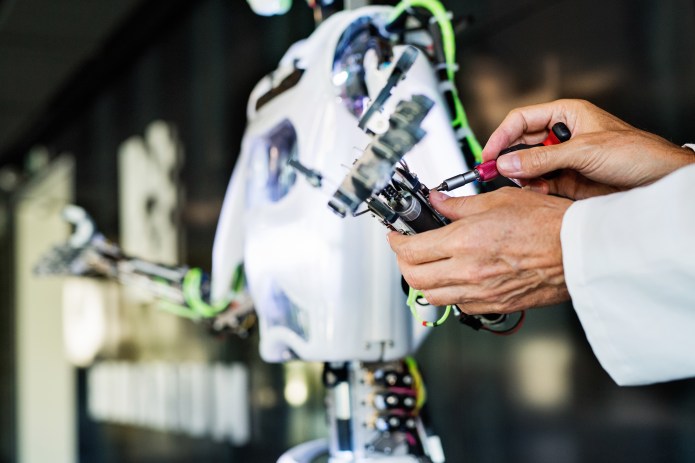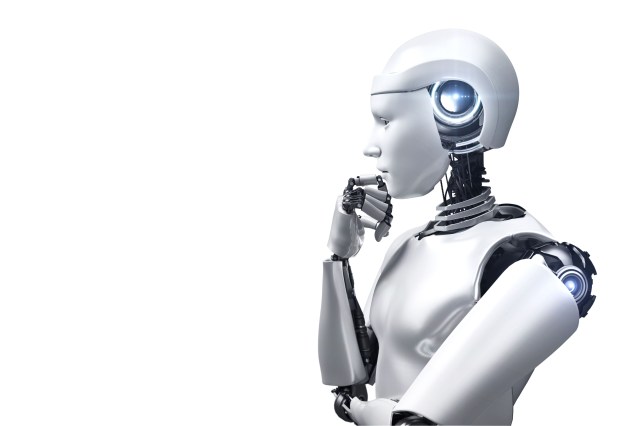
“We tend to overestimate the effect of a technology in the short run and underestimate the effect in the long run.”
Roy Amara, Futurologist
Elon Musk was quoted as saying “I think by 2040, there will probably be more humanoid robots than there are people.” While this sounds like a bold prediction, analysts are forecasting they could be a presence in our daily lives within the next decade. According to Morgan Stanley, 13 million human robots will be among us by 2035, rising to one billion by 2050, while Goldman Sachs forecasts that the market could reach US$38 billion in value by 2035.1
We remain early in the development of humanoids, but we view the technology as a core part of the broader AI wave. While copilots and AI agents exist purely in software, humanoid robots and autonomous vehicles (AVs) are representative of the maturation of AI and the advent of physical AI.
The launch of Tesla’s Optimus robotic humanoid, and ChatGPT within months of each other are indicative of the synergies that broader generative AI development and the use of large language models (LLMs) will have on humanoids. This AI flywheel creates greater confidence in the pathway of humanoid development, which will likely now come at a much faster pace, despite mass deployment being many years away.
Ultimately, we believe this solves problems for the major demographic challenge of our generation ─ an ageing population and a shrinking workforce in much of the developed world, as well as China. Humanoids will be a necessary technology solution to a diminishing number of humans available to work in factories. They can also improve safety and efficiency in the workplace, as well as increase productivity and accuracy for repetitive tasks, or care for a growing population of elderly humans, among many other examples.
State of play
At present we have only seen early types of humanoids working in manufacturing and warehouses, and not in our workplaces and homes yet. However, generative AI is helping to accelerate the development curve to solve current key challenges with humanoids. Among them are high-quality imitation learning from humans to facilitate smooth movement, as well as intelligence to plan for and perform higher utility tasks. This is evident from recent updates from Tesla, Unitree and Helix that have demonstrated step change functions in capability, including the combination of linear joints and rotary joints used by Tesla. In software, there has been significant progress in the development of humanoid brains in recent years with the advent of ChatGPT, DeepSeek and Vision-Language-Action (VLA) models.
Humanoid robots are nearing an inflection point, as we have similarly seen in autonomous vehicles. Alphabet-owned Waymo is now accelerating its fully autonomous rides rollout in the US and testing in Tokyo, while Tesla’s robotaxis have been launched in Austin, Texas. This is in addition to rollouts in the Middle East, and accelerated deployments in China.
Barriers to humanoid robot advancement
However, challenges still remain for the development and commercial adoption of humanoids:
- Humanoid brain development
Further progress in terms of visual, auditory and other perception systems is needed. Humanoids typically produce a slow response and often make errors when multi-tasking or placed in a dynamic environment eg. when lighting changes or having to navigate different terrains.
- Cost
The vast majority of the cost of a humanoid exists in the actuators (that convert energy into physical motion or force) and broader hardware of the design, where it is harder to achieve dramatic cost reductions. Additionally, other core components of humanoids like high-precision motors, ball/rollerscrews, and sensors are all dependent on high-precision manufacturing processes, while maintenance and software upgrades all need to be factored in.
- Battery life
Battery life for fully mobile untethered humanoids remain a key challenge, in terms of battery weight and limited operational time of a few hours currently.
- Regulation
As we have seen with autonomous vehicles, regulation is a key barrier towards mass adoption. There are no specific laws and regulations in place as yet. Responsibility needs to be determined with commercialisation, further concerns around the displacement of certain jobs by humanoids, data security and privacy.
How to participate today in the vast growth potential of humanoids tomorrow?
Companies such as Uber and DoorDash have been experimenting with AVs and humanoids to reduce human labour costs in the longer term, as is Amazon on the logistics side. Elsewhere, Intuitive Surgical is offering humanoid capability in the robotic surgery sphere.
While gaining direct exposure to humanoids remains limited today, there are multiple opportunities across the supply chain:
- Software
Generative AI has unlocked value-add AI software. This includes Google’s DeepMind, NVIDIA’s Cosmos, as well as Amazon and Microsoft both in terms of the direct robotics investments (e.g. Figure AI and Sanctuary AI) the companies have made to support their businesses, as well as for external customers in terms of the compute and AI offerings they provide via their hyperscaler cloud platforms. Tesla also has a strong franchise in humanoids given its vertical integration and scale.
- Hardware
Names such as Lattice Semiconductor can be viewed as an edge AI play of which humanoids would be one application, as well as Monolithic Power, which provides high performance power management for next generation applications including humanoids. Businesses such as Amphenol and TE Connectivity also have limited but growing exposure to the humanoid supply chain. Similarly, Qualcomm has a solid robotics platform, and humanoids would be another edge AI application for them, albeit a small part of their business today.
In other hardware areas, key players include existing robotics names like Harmonic Drive (actuators), and NSK (actuators, and ball bearings that enable movement in joints and limbs). These companies have the potential to benefit from humanoid robots’ rising dexterity requirements.
Risks and opportunities for companies
While no doubt there are exciting opportunities ahead, we believe there is significant risk as the AI development curve of humanoids accelerates. The value-add in humanoids is very much focused on the software layer, meaning traditional robotics companies could be left behind or disintermediated. Many of these companies are currently mainly exposed to the industrial cycle, which has been in the doldrums for the past two years and were showing green shoots of a cyclical recovery before the recent tariff uncertainty.
We continue to look for opportunities in this space to own high quality franchises enjoying a cyclical recovery, and to consider what may come as humanoid development and rollout becomes more advanced. There is also significant venture capital funding pouring into a plethora of humanoid startups across the world, notably in the US and China. OpenAI is well positioned but also new entrants like Skild.ai. Both of these companies are targeting the software layer, rather than trying to compete in the humanoid end market, which is already looking crowded as start-ups, electric vehicle makers, robotics companies and technology companies move in to join the humanoid revolution.
Another hype cycle to navigate
We believe it will be many years before humanoids will be deployed outside of controlled environments given the inherent dangers, safety and liability concerns involved, hence we must continue to navigate the hype cycle of these new technologies to identify the winners and avoid the losers. However, humanoids remain an important technology trend to keep abreast of, given the large potential addressable market as a substitution for labour, and ultimately, as a solution to the world’s ageing population dilemma.
1 Forbes:10 Amazing Humanoid Robots Already Walking Among Us Today, 15 July 2025. Goldman Sachs Research: The global market for humanoid robots could reach $38 billion by 2035, 27 February 2024.
Actuator: part of a device or machine that helps it to achieve physical movements by converting energy, often electrical, air, or hydraulic, into mechanical force. Simply put, it is the component in any machine that enables movement.
Generative AI: refers to deep-learning models that train on large volumes of raw data to generate ‘new content’ including text, images, audio and video.
Hyperscalers: companies that provide infrastructure for cloud, networking, and internet services at scale. Examples include Google Cloud, Microsoft Azure, Facebook Infrastructure, Alibaba Cloud, and Amazon Web Services.
LLM: a large language model is a specialised type of artificial intelligence that has been trained on vast amounts of text to understand existing content and generate original content.
Navigating the hype cycle: the hype cycle reflects a volatile, cyclical pattern of excessive optimism, followed by disillusionment, when a new technology or investment trend becomes popular. Markets typically overestimate the short-term potential of a new technology or innovation and underestimate its long-term potential, creating volatile movements both up and down for underlying stocks exposed to these technologies. Via active management, fund managers draw on their expertise and investment experience of investing through previous hype cycles aiming to deliver better investment outcomes.
Physical AI: the integration of sophisticated AI algorithms into tangible, interactive systems, enabling autonomous machines with cognitive reasoning and spatial knowledge to learn from their interactions and respond in real time. Examples include autonomous vehicles, surgical and humanoid robots.
Vision-language-action model: VLA models act like a human brain by integrating visual perception, natural language understanding, and real-world actions, enabling robots to comprehend and interact with their environment.
Key investment risks:
- The Fund's investments in equities are subject to equity securities risk due to fluctuation of securities values.
- Investments in the Fund involve general investment, currency, RMB currency and conversion, liquidity, hedging, market, economic, political, regulatory, taxation, securities lending related, reverse repurchase transactions related, financial and interest rate risks. In extreme market conditions, you may lose your entire investment.
- The Fund may invest in financial derivatives instruments to reduce risk and to manage the Fund more efficiently. This may involve counterparty, liquidity, leverage, volatility, valuation and over-the-counter transaction risks and the Fund may suffer significant losses.
- The Fund's investments are concentrated in technology sector and may be more volatile and subject to technology related companies risk.
- The Fund may invest in Eurozone and may suffer from Eurozone risk.
- The Fund may charge performance fees. An investor may be subject to such fee even if there is a loss in investment capital.
- Investors should not only base on this document alone to make investment decisions and should read the offering documents including the risk factors for further details.
